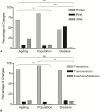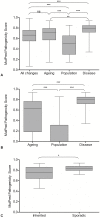Comparison of mitochondrial mutation spectra in ageing human colonic epithelium and disease: absence of evidence for purifying selection in somatic mitochondrial DNA point mutations
- PMID: 23166522
- PMCID: PMC3499406
- DOI: 10.1371/journal.pgen.1003082
Comparison of mitochondrial mutation spectra in ageing human colonic epithelium and disease: absence of evidence for purifying selection in somatic mitochondrial DNA point mutations
Abstract
Human ageing has been predicted to be caused by the accumulation of molecular damage in cells and tissues. Somatic mitochondrial DNA (mtDNA) mutations have been documented in a number of ageing tissues and have been shown to be associated with cellular mitochondrial dysfunction. It is unknown whether there are selective constraints, which have been shown to occur in the germline, on the occurrence and expansion of these mtDNA mutations within individual somatic cells. Here we compared the pattern and spectrum of mutations observed in ageing human colon to those observed in the general population (germline variants) and those associated with primary mtDNA disease. The pathogenicity of the protein encoding mutations was predicted using a computational programme, MutPred, and the scores obtained for the three groups compared. We show that the mutations associated with ageing are randomly distributed throughout the genome, are more frequently non-synonymous or frameshift mutations than the general population, and are significantly more pathogenic than population variants. Mutations associated with primary mtDNA disease were significantly more pathogenic than ageing or population mutations. These data provide little evidence for any selective constraints on the occurrence and expansion of mtDNA mutations in somatic cells of the human colon during human ageing in contrast to germline mutations seen in the general population.
Conflict of interest statement
The authors have declared that no competing interests exist.
Figures



Similar articles
-
Clonal expansion of early to mid-life mitochondrial DNA point mutations drives mitochondrial dysfunction during human ageing.PLoS Genet. 2014 Sep 18;10(9):e1004620. doi: 10.1371/journal.pgen.1004620. eCollection 2014 Sep. PLoS Genet. 2014. PMID: 25232829 Free PMC article.
-
Similar patterns of clonally expanded somatic mtDNA mutations in the colon of heterozygous mtDNA mutator mice and ageing humans.Mech Ageing Dev. 2014 Jul;139:22-30. doi: 10.1016/j.mad.2014.06.003. Epub 2014 Jun 7. Mech Ageing Dev. 2014. PMID: 24915468 Free PMC article.
-
Somatic mitochondrial DNA mutations in cancer escape purifying selection and high pathogenicity mutations lead to the oncocytic phenotype: pathogenicity analysis of reported somatic mtDNA mutations in tumors.BMC Cancer. 2012 Feb 2;12:53. doi: 10.1186/1471-2407-12-53. BMC Cancer. 2012. PMID: 22299657 Free PMC article. Review.
-
Germline mitochondrial DNA mutations aggravate ageing and can impair brain development.Nature. 2013 Sep 19;501(7467):412-5. doi: 10.1038/nature12474. Epub 2013 Aug 21. Nature. 2013. PMID: 23965628 Free PMC article.
-
Mitochondrial DNA mutation and the ageing process: bioenergy and pharmacological intervention.Mutat Res. 1992 Sep;275(3-6):195-208. doi: 10.1016/0921-8734(92)90023-i. Mutat Res. 1992. PMID: 1383761 Review.
Cited by
-
Parkinson's disease: a complex interplay of mitochondrial DNA alterations and oxidative stress.Int J Mol Sci. 2013 Jan 24;14(2):2388-409. doi: 10.3390/ijms14022388. Int J Mol Sci. 2013. PMID: 23348931 Free PMC article.
-
Heterologous Inferential Analysis (HIA) and Other Emerging Concepts: In Understanding Mitochondrial Variation In Pathogenesis: There is no More Low-Hanging Fruit.Methods Mol Biol. 2021;2277:203-245. doi: 10.1007/978-1-0716-1270-5_14. Methods Mol Biol. 2021. PMID: 34080154
-
Mitochondrial quality control mechanisms as molecular targets in cardiac ageing.Nat Rev Cardiol. 2018 Sep;15(9):543-554. doi: 10.1038/s41569-018-0059-z. Nat Rev Cardiol. 2018. PMID: 30042431 Free PMC article. Review.
-
The role of the mitochondrial ribosome in human disease: searching for mutations in 12S mitochondrial rRNA with high disruptive potential.Hum Mol Genet. 2014 Feb 15;23(4):949-67. doi: 10.1093/hmg/ddt490. Epub 2013 Oct 2. Hum Mol Genet. 2014. PMID: 24092330 Free PMC article.
-
High-frequency and functional mitochondrial DNA mutations at the single-cell level.Proc Natl Acad Sci U S A. 2023 Jan 3;120(1):e2201518120. doi: 10.1073/pnas.2201518120. Epub 2022 Dec 28. Proc Natl Acad Sci U S A. 2023. PMID: 36577067 Free PMC article.
References
-
- Troen BR (2003) The biology of aging. Mt Sinai J Med 70: 3–22. - PubMed
-
- Kirkwood TB, Melov S (2011) On the programmed/non-programmed nature of ageing within the life history. Curr Biol 21: R701–707. - PubMed
-
- Kirkwood TB (1977) Evolution of ageing. Nature 270: 301–304. - PubMed
-
- Kirkwood TB (2005) Understanding the odd science of aging. Cell 120: 437–447. - PubMed
-
- Linnane AW, Marzuki S, Ozawa T, Tanaka M (1989) Mitochondrial DNA mutations as an important contributor to ageing and degenerative diseases. Lancet 1: 642–645. - PubMed
Publication types
MeSH terms
Substances
Grants and funding
LinkOut - more resources
Full Text Sources
Medical

